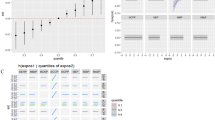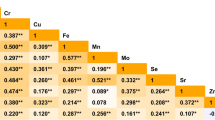Abstract
Few studies are available on associations between metal mixture exposures and disrupted thyroid hormone homeostasis; particularly, the role of iodine status was ignored. Here, we aimed to explore the cross-sectional relationship of blood cell metals with thyroid homeostasis and explore the potential modifying effect of iodine status. Among 328 workers from the manganese-exposed workers healthy cohort (MEWHC), we detected thyroid function parameters: thyroid stimulating hormone (TSH), total triiodothyronine (TT3), free triiodothyronine (FT3), total tetraiodothyronine (TT4), free tetraiodothyronine (FT4) as well as calculated sum activity of peripheral deiodinases (GD) and thyroid’s secretory capacity (GT). Inductively coupled plasma mass spectrometry (ICP-MS) was used to measure 22 metal concentrations in blood cells. Based on the consistent results of least absolute shrinkage and selection operator (LASSO) and Bayesian kernel machine regression (BKMR) analyses, there were significant positive associations between copper and TSH (β = 2.016), iron and FT4 (β = 0.403), titanium and GD (β = 0.142), nickel and GD (β = 0.057), and negative associations between copper and FT4 (β = − 0.226), selenium and GD (β = − 0.332), among the participants. Interestingly, we observed an inverted-U shape relationship between magnesium and FT4. Furthermore, we found a synergistic effect between arsenic and copper on the TSH level, while antagonistic effects between nickel and copper as well as nickel and selenium on the TSH level. We observed a modified effect of iodine status on association between strontium and GD (Pinteraction = 0.026). It suggests metal mixture exposures can alter thyroid homeostasis among the occupational population, and deiodinase activity had a modified effect on association between strontium and GD. Validation of these associations and elucidation of underlying mechanisms require further researches in the future.


Similar content being viewed by others
Data availability
Data will be made available on reasonable request.
Abbreviations
- MEWHC:
-
Manganese-exposed workers healthy cohort
- TSH:
-
Thyroid stimulating hormone
- TT3:
-
Total triiodothyronine
- FT3:
-
Free triiodothyronine
- TT4:
-
Total tetraiodothyronine
- FT4:
-
Free tetraiodothyronine
- GD :
-
Sum activity of peripheral deiodinases
- GT :
-
Thyroid's secretory capacity
- ICP-MS:
-
Inductively coupled plasma mass spectrometry
- LASSO:
-
Least absolute shrinkage and selection operator
- BKMR:
-
Bayesian kernel machine regression
- Cu:
-
Copper
- Fe:
-
Iron
- Ti:
-
Titanium
- Ni:
-
Nickel
- Se:
-
Selenium
- Mg:
-
Magnesium
- As:
-
Arsenic
- Sr:
-
Strontium
- Mg:
-
Magnesium
- Ca:
-
Calcium
- V:
-
Vanadium
- Cr:
-
Chromium
- Mn:
-
Manganese
- Co:
-
Cobalt
- Zn:
-
Zinc
- Rb:
-
Rubidium
- Mo:
-
Molybdenum
- Cd:
-
Cadmium
- Sn:
-
Tin
- Sb:
-
Antimony
- Ba:
-
Barium
- Pb:
-
Lead
- LOD:
-
Limit of detection
- BMI:
-
Body mass index
- MSE:
-
Mean square error
- GLM:
-
General liner model
- PIP:
-
Posterior inclusion probabilities
- TPO:
-
Heme-containing thyroperoxidases
References
Boas M, Main KM, Feldt-Rasmussen U (2009) Environmental chemicals and thyroid function: an update. Curr Opin Endocrinol Diabetes Obes 16:385–391
Bobb JF, Claus Henn B, Valeri L et al (2018) Statistical software for analyzing the health effects of multiple concurrent exposures via Bayesian kernel machine regression. Environ Health 17:67
Chen A, Kim SS, Chung E et al (2013) Thyroid hormones in relation to lead, mercury, and cadmium exposure in the National Health and Nutrition Examination Survey, 2007–2008. Environ Health Perspect 121:181–186
Chung SM, Moon JS, Yoon JS et al (2019) Sex-specific effects of blood cadmium on thyroid hormones and thyroid function status: Korean nationwide cross-sectional study. J Trace Elem Med Biol 53:55–61
Conley JM, Lambright CS, Evans N et al (2021) A mixture of 15 phthalates and pesticides below individual chemical no observed adverse effect levels (NOAELs) produces reproductive tract malformations in the male rat. Environ Int 156:106615
Demeneix BA (2019) Evidence for prenatal exposure to thyroid disruptors and adverse effects on brain development. Eur Thyroid J 8:283–292
Dietrich JW, Landgrafe-Mende G, Wiora E et al (2016) Calculated parameters of thyroid homeostasis: emerging tools for differential diagnosis and clinical research. Front Endocrinol (lausanne) 7:57
Gorini F, Bustaffa E, Coi A, et al (2020) Bisphenols as environmental triggers of thyroid dysfunction: clues and evidence. Int J Environ Res Public Health 17
Guo J, Lv N, Tang J et al (2018) Associations of blood metal exposure with thyroid hormones in Chinese pregnant women: a cross-sectional study. Environ Int 121:1185–1192
He J, Ge X, Cheng H et al (2022) Sex-specific associations of exposure to metal mixtures with telomere length change: results from an 8-year longitudinal study. Sci Total Environ 811:151327
Heitland P, Koster HD (2021) Human biomonitoring of 73 elements in blood, serum, erythrocytes and urine. J Trace Elem Med Biol 64:126706
Hu MJ, Zhu JL, Zhang Q et al (2021) Thyroid hormones in relation to polybrominated diphenyl ether and metals exposure among rural adult residents along the Yangtze River, China. Int J Hyg Environ Health 236:113800
Jabbar A, Pingitore A, Pearce SH et al (2017) Thyroid hormones and cardiovascular disease. Nat Rev Cardiol 14:39–55
Jiang Y, Zheng W, Long L et al (2007) Brain magnetic resonance imaging and manganese concentrations in red blood cells of smelting workers: search for biomarkers of manganese exposure. Neurotoxicology 28:126–135
Jones JE, Desper PC, Shane SR et al (1966) Magnesium metabolism in hyperthyroidism and hypothyroidism. J Clin Invest 45:891–900
Kim MJ, Kim S, Choi S et al (2021) Association of exposure to polycyclic aromatic hydrocarbons and heavy metals with thyroid hormones in general adult population and potential mechanisms. Sci Total Environ 762:144227
Kim K, Argos M, Persky VW et al (2022) Associations of exposure to metal and metal mixtures with thyroid hormones: results from the NHANES 2007–2012. Environ Res 212:113413
Krieg EF Jr (2016) A meta-analysis of studies investigating the effects of occupational lead exposure on thyroid hormones. Am J Ind Med 59:583–590
Lin PD, Cardenas A, Rifas-Shiman SL et al (2021) Diet and erythrocyte metal concentrations in early pregnancy-cross-sectional analysis in Project Viva. Am J Clin Nutr 114:540–549
Long Z, Jiang YM, Li XR et al (2014) Vulnerability of welders to manganese exposure–a neuroimaging study. Neurotoxicology 45:285–292
Lv Y, Zou Y, Liu J et al (2014) Rationale, design and baseline results of the Guangxi manganese-exposed workers healthy cohort (GXMEWHC) study. BMJ Open 4:e005070
Margetaki K, Vafeiadi M, Kampouri M et al (2021) Associations of exposure to cadmium, antimony, lead and their mixture with gestational thyroid homeostasis. Environ Pollut 289:117905
Miller MD, Crofton KM, Rice DC et al (2009) Thyroid-disrupting chemicals: interpreting upstream biomarkers of adverse outcomes. Environ Health Perspect 117:1033–1041
Nie X, Chen Y, Chen Y et al (2017) Lead and cadmium exposure, higher thyroid antibodies and thyroid dysfunction in Chinese women. Environ Pollut 230:320–328
Ou SY, Luo HL, Mailman RB et al (2018) Effect of manganese on neural endocrine hormones in serum of welders and smelters. J Trace Elem Med Biol 50:1–7
Rana SV (2014) Perspectives in endocrine toxicity of heavy metals–a review. Biol Trace Elem Res 160:1–14
Reinehr T, Isa A, de Sousa G et al (2008) Thyroid hormones and their relation to weight status. Horm Res 70:51–57
Rong F, Dai H, Wu Y et al (2021) Association between thyroid dysfunction and type 2 diabetes: a meta-analysis of prospective observational studies. BMC Med 19:257
Smith SM, Johnson PE, Lukaski HC (1993) In vitro hepatic thyroid hormone deiodination in iron-deficient rats: effect of dietary fat. Life Sci 53:603–609
Stoker TE, Laws SC, Crofton KM et al (2004) Assessment of DE-71, a commercial polybrominated diphenyl ether (PBDE) mixture, in the EDSP male and female pubertal protocols. Toxicol Sci 78:144–155
Sun X, Liu W, Zhang B et al (2019) Maternal heavy metal exposure, thyroid hormones, and birth outcomes: a prospective cohort study. J Clin Endocrinol Metab 104:5043–5052
Talebi S, Ghaedi E, Sadeghi E et al (2020) Trace element status and hypothyroidism: a systematic review and meta-analysis. Biol Trace Elem Res 197:1–14
Thomsen AR, Worm J, Jacobsen SE et al (2012) Strontium is a biased agonist of the calcium-sensing receptor in rat medullary thyroid carcinoma 6–23 cells. J Pharmacol Exp Ther 343:638–649
Wang K, Wei H, Zhang W et al (2018) Severely low serum magnesium is associated with increased risks of positive anti-thyroglobulin antibody and hypothyroidism: A cross-sectional study. Sci Rep 8:9904
Wang X, Sun X, Zhang Y et al (2020) Identifying a critical window of maternal metal exposure for maternal and neonatal thyroid function in China: a cohort study. Environ Int 139:105696
Wu X, Cobbina SJ, Mao G et al (2016) A review of toxicity and mechanisms of individual and mixtures of heavy metals in the environment. Environ Sci Pollut Res Int 23:8244–8259
Wu W, Lu J, Ruan X et al (2021) Maternal essential metals, thyroid hormones, and fetal growth: association and mediation analyses in Chinese pregnant women. J Trace Elem Med Biol 68:126809
Ye Y, Li Y, Ma Q et al (2023) Association of multiple blood metals with thyroid function in general adults: a cross-sectional study. Front Endocrinol (lausanne) 14:1134208
Yorita Christensen KL (2013) Metals in blood and urine, and thyroid function among adults in the United States 2007–2008. Int J Hyg Environ Health 216:624–632
Zhou Y, Ge X, Shen Y et al (2018) Follow-up of the manganese-exposed workers healthy cohort (MEWHC) and biobank management from 2011 to 2017 in China. BMC Public Health 18:944
Acknowledgements
We thank all our colleagues and subjects who participated in this study.
Funding
This work was financially supported by the National Natural Science Foundation of China (Nos. U21A20340 and 82073504) and Middle-aged and Young Teachers’ Basic Ability Promotion Project of Guangxi (No. 2023KY0347).
Author information
Authors and Affiliations
Contributions
Xiaoting Ge: writing — original draft, writing — review and editing. Junxiu He: writing — original draft, writing — review and editing. Sencai Lin: writing — original draft, writing — review and editing. Yu Bao: investigation and data curation. Yuan Zheng: investigation and data curation. Hong Cheng: investigation and data curation. Haiqing Cai: investigation and data curation. Xiuming Feng: investigation and data curation. Wenjun Yang: investigation and data curation. Sihan Hu: investigation and data curation. Lin Wang: investigation and data curation. Qijing Liao: investigation and data curation. Fei Wang: writing — review and editing. Chaoqun Liu: writing — review and editing. Xing Chen: writing — review and editing. Yunfeng Zou: conceptualization. Xiaobo Yang: supervision and project administration.
Corresponding author
Ethics declarations
Ethical approval
The study was approved by the medical ethics committee at Guangxi Medical University (ID: 20220017).
Consent to participate
All the authors agreed to participate.
Consent for publication
All the authors agreed to the publication.
Competing interests
The authors declare no competing interests.
Additional information
Responsible Editor: Lotfi Aleya
Publisher's Note
Springer Nature remains neutral with regard to jurisdictional claims in published maps and institutional affiliations.
Highlights
• An inverted-U shape relationship was observed between Mg and free tetraiodothyronine.
• A synergistic effect can be found between As and Cu on thyroid stimulating hormone level.
• An antagonistic effect can be found between Ni-Cu and Ni-Se on thyroid stimulating hormone level.
• Iodine status has a modified effect on association between Sr and sum activity of peripheral deiodinases.
Supplementary Information
Below is the link to the electronic supplementary material.
Rights and permissions
Springer Nature or its licensor (e.g. a society or other partner) holds exclusive rights to this article under a publishing agreement with the author(s) or other rightsholder(s); author self-archiving of the accepted manuscript version of this article is solely governed by the terms of such publishing agreement and applicable law.
About this article
Cite this article
Ge, X., He, J., Lin, S. et al. Associations of metal mixtures with thyroid function and potential interactions with iodine status: results from a cross-sectional study in MEWHC. Environ Sci Pollut Res 30, 105665–105674 (2023). https://doi.org/10.1007/s11356-023-29682-4
Received:
Accepted:
Published:
Issue Date:
DOI: https://doi.org/10.1007/s11356-023-29682-4




